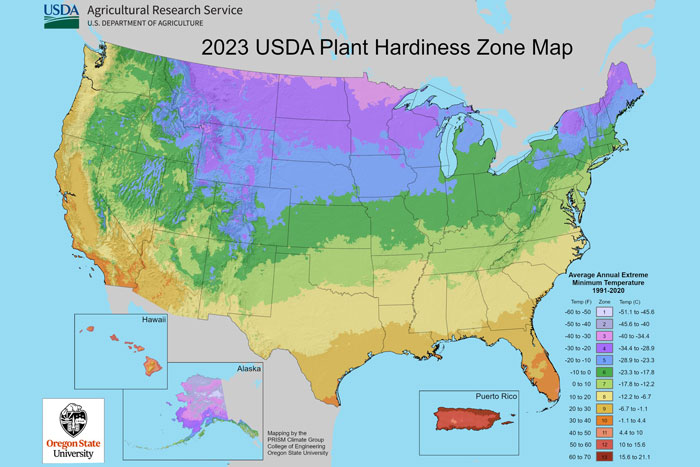What is the Planting Zone in Missouri?
Understanding the planting zone in Missouri is crucial for gardeners and farmers alike, as it helps determine which plants will thrive in the region’s climate. The planting zone, often referred to as the hardiness zone, is based on the average minimum winter temperatures and guides individuals in selecting appropriate plants for their gardens.
Overview of Plant Hardiness Zones
The USDA Plant Hardiness Zone Map is a standard used by gardeners and growers to determine which plants are most likely to thrive in specific locations based on climate conditions. The map divides the United States into 13 zones, each representing a 10-degree Fahrenheit range of average annual minimum temperatures. Each zone is further subdivided into “a” and “b” subzones, indicating slightly warmer or cooler conditions.
Missouri’s Hardiness Zones
Missouri’s climate has undergone changes over the years, leading to adjustments in its hardiness zones. The latest USDA map classifies Missouri into the following hardiness zones:
- Zone 5b: Average minimum temperatures of -10°F to -5°F (-20.6°C to -15°C)
- Zone 6a: Average minimum temperatures of -5°F to 0°F (-20.6°C to -17.8°C)
- Zone 6b: Average minimum temperatures of 0°F to 5°F (-17.8°C to -15°C)
- Zone 7a: Average minimum temperatures of 5°F to 10°F (-15°C to -12.2°C)
- Zone 7b: Average minimum temperatures of 10°F to 15°F (-12.2°C to -9.4°C)
Most of Missouri falls within zones 6a and 6b, with the southern parts of the state reaching into zone 7a and 7b. This distribution indicates that the northern regions of Missouri experience colder winters compared to the southern areas.
Climate Characteristics in Missouri
Missouri experiences a humid continental climate, characterized by four distinct seasons. The state has hot, humid summers and cold, snowy winters, with significant variations in temperature and precipitation throughout the year.
Summers
- Temperature: Average high temperatures in summer range from the upper 80s°F (around 30°C) to low 90s°F (approximately 34°C).
- Humidity: High humidity levels can make summer temperatures feel even hotter, often leading to heat indices exceeding 100°F (37.8°C).
- Precipitation: Summer is also the wettest season, with frequent thunderstorms and heavy rainfall.
Winters
- Temperature: Average winter high temperatures range from the upper 30s°F (around 3°C) to low 40s°F (approximately 5°C), while lows can drop into the 20s°F (-6.7°C to -3.9°C).
- Snowfall: Missouri receives an average of 16 inches (40.6 cm) of snowfall annually, with the most significant snowfall typically occurring in January and February.
Spring and Fall
- Spring: Spring is characterized by variable weather, with temperatures gradually warming and increased precipitation. It is a crucial time for planting as the risk of frost diminishes.
- Fall: Fall brings cooler temperatures and is generally dry, making it a favorable time for harvesting crops and preparing gardens for winter.
Implications for Gardening and Agriculture
Knowing the planting zone in Missouri is essential for selecting appropriate plants for gardens and agricultural activities. Here are some key considerations:
Plant Selection
Gardeners should choose plants that are rated for their specific hardiness zone. For example, if you live in zone 6b, selecting plants rated for zones 5a or 5b can provide an extra margin of safety against extreme cold.
Timing for Planting
Understanding the climate and hardiness zone helps determine the best planting times for various crops and flowers. For instance, cool-season crops like lettuce and peas can be planted in early spring, while warm-season crops like tomatoes and peppers should be planted after the last frost date, typically in mid-April.
Crop Rotation and Diversity
Farmers in Missouri can benefit from understanding their hardiness zones to implement effective crop rotation strategies. Planting a diverse range of crops can improve soil health and reduce the risk of pests and diseases.
Adapting to Climate Change
Climate change is impacting weather patterns across Missouri, leading to shifts in hardiness zones and affecting agricultural practices. Some observed changes include:
- Warmer Winters: Many areas in Missouri are experiencing milder winters, allowing for a broader range of plants to be cultivated.
- Increased Precipitation: The state has seen an increase in heavy rainfall events, which can lead to flooding and affect planting schedules.
- Drought Conditions: Conversely, some regions may experience drought conditions during the summer months, necessitating the use of drought-resistant plants and efficient irrigation techniques.
Gardening Tips for Missouri
To successfully garden in Missouri’s climate, consider the following tips:
- Choose the Right Plants: Select plants that are suited to your specific hardiness zone. Consult local gardening resources or extension services for recommendations.
- Monitor Frost Dates: Keep track of the average last frost date in spring and the first frost date in fall to optimize planting schedules.
- Implement Water-Saving Techniques: Use mulch, drip irrigation, and rain barrels to conserve water, especially during dry spells.
- Prepare for Extreme Weather: Be proactive in protecting plants from extreme heat, cold, and heavy rainfall. Consider using row covers, stakes, or other protective measures as needed.
- Stay Informed: Keep up to date with local weather forecasts and climate trends to make informed decisions about planting and garden management.
Table: Hardiness Zones in Missouri
| Zone | Average Minimum Temperature | Description |
|---|---|---|
| 5b | -10°F to -5°F (-20.6°C to -15°C) | Northern Missouri, suitable for cold-hardy plants |
| 6a | -5°F to 0°F (-20.6°C to -17.8°C) | Central Missouri, moderate winter temperatures |
| 6b | 0°F to 5°F (-17.8°C to -15°C) | Southern-central Missouri, mild winter conditions |
| 7a | 5°F to 10°F (-15°C to -12.2°C) | Southern Missouri, warmer winters |
| 7b | 10°F to 15°F (-12.2°C to -9.4°C) | Extreme southern Missouri, suitable for a wider range of plants |
Frequently Asked Questions (FAQ)
1. What is the average planting zone in Missouri?
Missouri has several planting zones, primarily ranging from 5b to 7b, with most areas falling into zones 6a and 6b.
2. How can I find my specific planting zone in Missouri?
You can find your specific planting zone by consulting the USDA Plant Hardiness Zone Map, which provides detailed information based on your location.
3. What types of plants are suitable for Missouri’s hardiness zones?
Plants suitable for Missouri’s hardiness zones include a variety of trees, shrubs, perennials, and annuals. Popular choices include oak, maple, dogwood, azalea, daylily, and coneflower.
4. When is the best time to plant in Missouri?
The best time to plant varies by crop type. Cool-season crops can be planted in early spring, while warm-season crops should be planted after the last frost date, typically in mid-April.
5. How does climate change affect planting zones in Missouri?
Climate change is leading to warmer winters and increased precipitation, which may shift hardiness zones northward and affect which plants can be successfully grown.
6. What resources are available for gardeners in Missouri?
Gardeners in Missouri can access resources from the University of Missouri Extension, local garden clubs, and the Missouri Botanical Garden for information on gardening practices and plant selection.
7. Can I grow tropical plants in Missouri?
While some tropical plants may survive in Missouri during the summer, they typically cannot withstand the winter temperatures. Consider growing them as annuals or bringing them indoors during colder months.
8. What are some common gardening challenges in Missouri?
Common gardening challenges in Missouri include dealing with temperature extremes, managing pests and diseases, and adapting to changing precipitation patterns.
Conclusion
Understanding the planting zone in Missouri is essential for successful gardening and agriculture. By selecting appropriate plants for their specific hardiness zone and adapting to changing climate conditions, gardeners and farmers can thrive in this diverse and dynamic region. For more detailed information on plant hardiness zones, you can refer to the USDA Plant Hardiness Zone Map.

